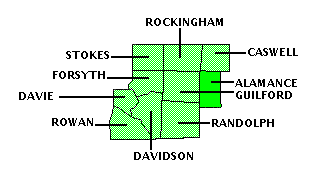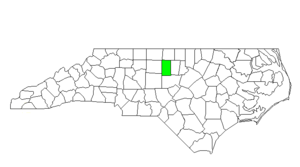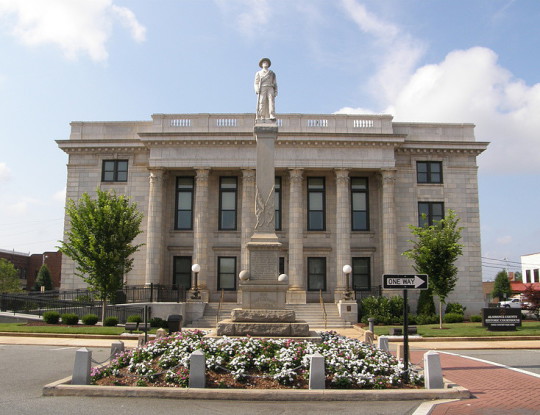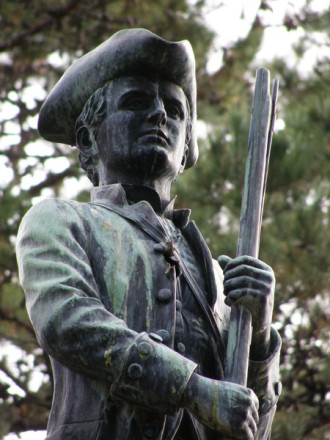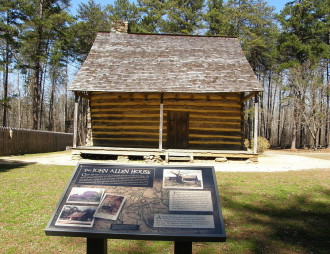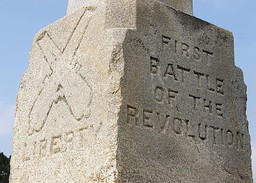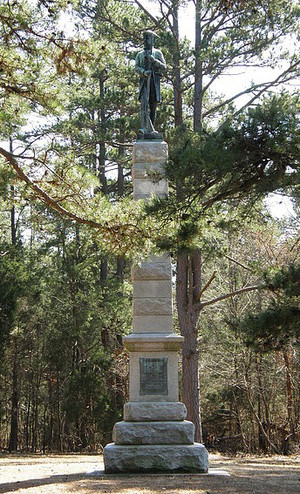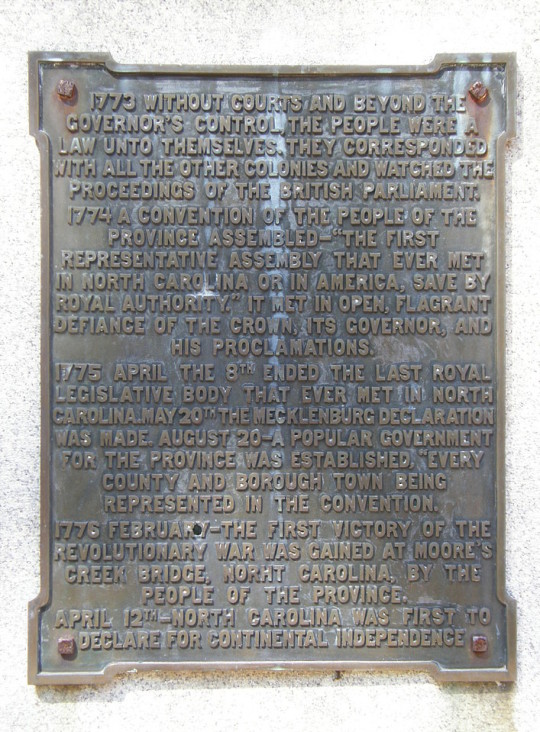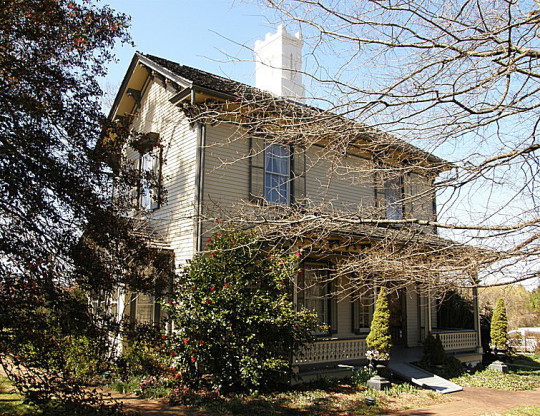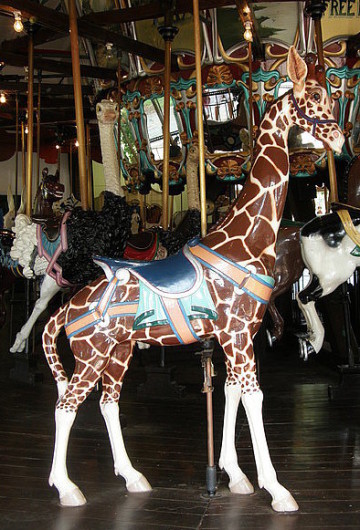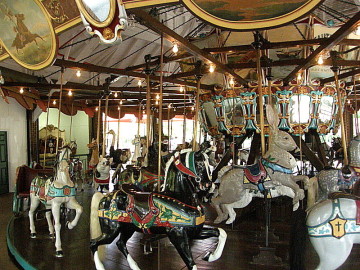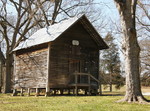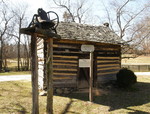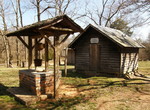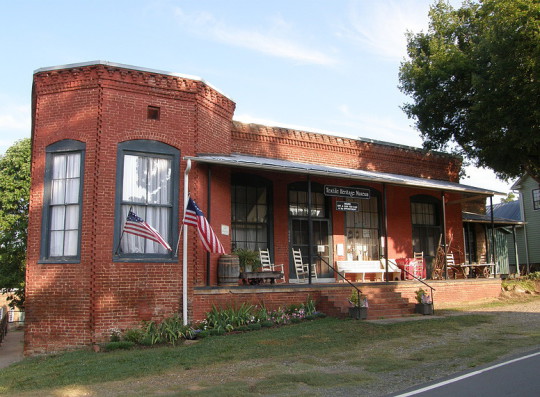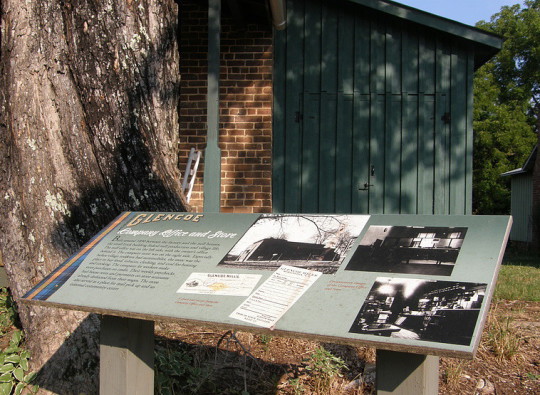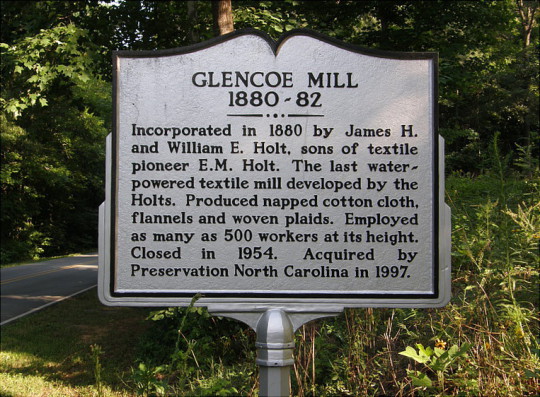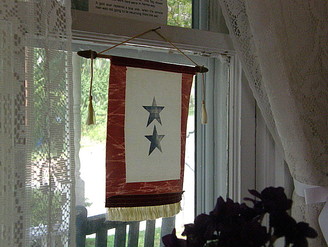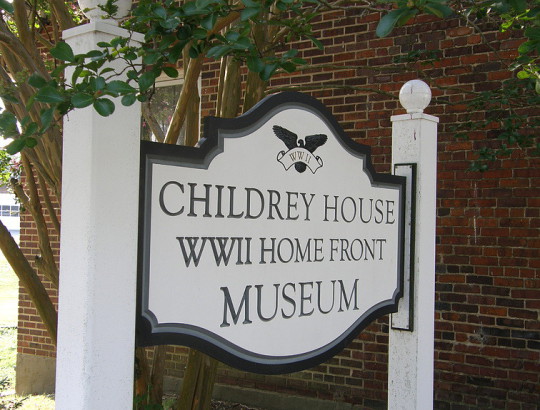ALAMANCE COUNTY
Scroll down this page or click on specific site name to view features on the following Alamance County attractions/points of interest:
Alamance Battleground State Historic Site, Alamance County Historical Museum, Burlington City Park, Cedarock Historical Park, Textile Heritage Museum, World War II Homefront Museum
Fast facts about Alamance County:
Created in 1849, the name Alamance was derived either from the local Native American word meaning “blue clay,” and which is found in Alamance Creek, or in recognition of the Battle of Alamance.
The county seat is Graham, named in honor of William A. Graham, a North Carolina governor. Other communities include Alamance, Burlington, Elon, Green Level, Haw River, and Snow Camp.
The land area of Alamance County is 429.99 square miles; the population in the 2010 census was 151,131.
It is noteworthy that the Battle of Alamance, fought May 16, 1771, was long considered by many to be the first battle of the American Revolution; Edwin M. Holt began the first large-scale textile mill in Alamance County in 1837 and introduced the popular Alamance Plaids.
Below: Alamance County Courthouse, Graham
Alamance
Alamance Battleground State Historic Site, a few miles south of Burlington, recalls the history of the little known but highly important “Regulator Movement” in North Carolina in the years just prior to the American Revolution. The site preserves the field of battle where, on May 16, 1771, over 2,000 backcountry insurgents engaged 1,100 colonial militia commanded by Royal Governor William Tryon. At issue was what the piedmont farmers regarded as unfair treatment at the hands of the Provincial government controlled by the eastern counties.
After years of trying to gain redress peacefully, the west-erners finally resorted to acts of vandalism and harassment. The increasingly hostile actions of this loosely organized group of so-called “Regulators” ultimately resulted in Governor Tryon calling forth the militia. The two sides met in the heart of Regulator country, but the su-periority of numbers enjoyed by the insurgents was offset by their lack of arms and military training. Few lives were lost during the battle, but the outcome was decisive. The militia routed the disorganized farmers and ended the Regulator movement once and for all. Twelve of the captured Regulators were put on trial in Hillsborough; six were convicted and executed. Most of the insurgents, however, were allowed to return to their homes upon giving an oath of loyalty to the King. While the Regulators themselves were defeated, their cause was not, and when the first constitution for the state of North Carolina was written in 1776, many of the complaints of the backcountry farmers were specifically addressed.
A small visitor center across the street from the battlefield features a 20-minute video detailing the reasons behind the Regulator movement and the climactic battle at Alamance. A short distance from the center is a single-room log dwelling with loft, circa 1780, which was moved to the site from the nearby community of Snow Camp. The house had belonged to John Allen; his wife Amy was the sister of Herman Husband, one of the more outspoken proponents of the Regulator Movement. On the opposite side of the highway is the field where most of the action took place. Under a wooden shelter is a large tablet, part of the state's system of highway historical markers, which provides a detailed account of the events of the battle.
Two monuments serve as focal points on the field. The first is a simple, 13-foot granite marker erected in 1880 by citizens of the county. It was commonly held at this time that the fighting spirit demonstrated by the Regulators against royal authority in 1771 gave Alamance claim to having been the first battle of the American Revolution, and the monument is so inscribed.
The so-called "Regulator Column" stands nearby, moved to its current location in 1962 from the Guilford Courthouse National Military Park in Greensboro, where it was first erected in 1901. This column is sometimes referred to as the James Hunter monument, Hunter being another of the more prominent figures of the Regulator movement. A tablet on the base of this monument summarizes the activities which took place during the years 1773-1776 that put North Carolina at the forefront of the fight for independence. These events include the meeting of the First Provincial Congress in August, 1774, the first assembly to take place without the expressed approval of the British government anywhere in the thirteen colonies; the Mecklenburg Declaration of Independence of May 20, 1775; and the Halifax Resolves of April 12, 1776, at which time North Carolina became the first colony to authorize its delegates attending the Second Continental Congress in Philadelphia to vote for independency.
A replica 3-pounder cannon is located on the grounds; two cannons of this type were used by Tryon's militia during the two hour engagement. Alamance Battleground is situated six miles southwest of I-85/I-40 (Exit 143) on NC 62. Hours for Alamance Battleground are 9-5 Tuesday-Saturday. 336-227-4785
Alamance
The Alamance County Historical Museum occupies what had been the home to three generations of the Holt family. Michael Holt III built the first portion of the house in 1790, a simple two-room hall-and-parlor construction. His son, Edwin M. Holt, added a two-story wing to the house in 1800. Grandson Lynn Banks Holt added the third and final addition in 1875, at which time the house was also embellished with architectural features characteristic of the Italianate Revival style then in fashion. Edwin Holt introduced the textile industry to the Carolina piedmont when he established the Alamance Cotton Factory along Alamance Creek in 1837. It was here that the cotton fabrics known as “Alamance Plaids” originated in the 1850s; they were the first commercially produced plaids in the southeastern United States.
The museum displays a wealth of 19th century furnishings, including a table by noted North Carolina artisan Thomas Day. In addition, a number of family belongings are showcased, among them books from the library of Thomas Holt (originator of the aforementioned Alamance Plaids and North Carolina governor from 1891-1895), delicate china hand-painted by Mary Catherine Holt, wife of Lynn Holt, and a portrait of Edwin’s son-in-law, James Williamson, one of the founders of the financial institution that gradually evolved into today’s Bank of America. The museum also devotes an entire room to depict the textile industry that played a crucial role in the region’s economy for a century-and-a-half. An original painting by renowned artist Mort Kunstler showing Thomas Holt at work in the dye house is prominently displayed. Also located on the property are a carriage house, a granary, a reconstructed two-room brick kitchen, and the Holt family graveyard. The Alamance County Historical Museum is open 9-4:30 Tuesday-Friday, 1-4:30 Saturday, and 1-4:30 Sunday, except Thanksgiving and Christmas. 336-226-8254
Burlington
It may be the allure of the colorful carved animals themselves, the jaunty rhythms of the calliope, the hypnotic motion of the circling lights and figures, or all these elements working together, but it seems almost everyone enjoys a carousel. When the merry-go-round in question is an early 20th-century Dentzel Menagerie Carousel, the attraction is even greater. Just such a treasure is the centerpiece of the 75-acre Burlington City Park, which also features a miniature train, three other rides especially for young children, a playground, picnic facilities, tennis courts, and five softball fields. Burlington’s Menag-erie Carousel was manufactured at the Dentzel Carousel Company in Philadelphia, Pennsylvania circa 1906-1910, during the “Golden Age” of merry-go-round construction. After delighting riders at amusement parks in Ohio for roughly four decades, the Burlington carousel was purchased by the city in the summer of 1948, and it’s been attracting families from Burlington and outlying areas ever since.
Each year, thousands of riders go for a spin on the finely-restored carousel. The 3-row merry-go-round includes 26 finely rendered horses, accented with glass eyes and real horse hair. Joining the glistening steeds are four each of ostriches, rabbits, cats, and pigs. Rounding out the menagerie are one each of a reindeer, giraffe, lion, and tiger. Animals on the outside row are attached to stationery poles; those on the two inside rows are mounted on poles that cause them to move up and down as the carousel turns. All animals are hand carved from bass and poplar wood by Dentzel craftsmen who were especially noted for their skilled rendering of the veins and muscles of the animals. Adding to the dramatic appearance of the merry-go-round are mirrors, lights, and rounding boards featuring pastoral scenes. The carousel is sheltered under a handsome brick pavilion, and this glittering jewel of Americana is listed on the National Historic Register.
Another popular attraction at Burlington City Park is the train. A 4-cyclinder, 3-speed, gas-powered engine pulls three passenger cars for a short trip along a tree-lined track and through the seemingly obligatory tunnel. For the younger kids, the park has plane, helicopter, and boat rides. The playground also includes an assortment of slides, swings, see-saws, and monkey bars. A snack bar offers tasty treats and there are many picnic tables available. Rest rooms are conveniently located nearby. All in all, the park affords families with a fun-filled, economical outing. Burlington City Park’s amusement area is open seasonally from Easter weekend through Halloween. Hours are 1-8 Tuesday-Thursday; 1-9 Friday; 11-9 Saturday; and 1-7 Sunday. Tickets for all rides are $.75. 336-222-5030
Graham
Cedarock Historical Park is the site of John and Polly Garrett’s homestead. The site includes many of the 115-acre farm’s original buildings, among them the single room cabin, built in 1830, that was home to John and Polly for five years until a larger, two-story frame house could be completed. The cabin then served as the kitchen. Surviving dependencies include the loom house, smoke house, well, corncrib, and carriage shed. Another small structure, which served as a post office during the 1870s-1880s, also survives. A new blacksmith shop stands next to the carriage shed, and a modern barn, containing a collection of vintage farm equipment, stands at the rear of the property. Cedarock Historic Park grounds are open daily for self-guided tours. Admission is free. 336-570-6769
Burlington
The Textile Heritage Museum occupies the former company store and office building of the Glencoe Cotton Mill. Focused on the textile history of Alamance County and the North Carolina Piedmont, the Museum examines the development of the industry, the family labor system, and mill village life. Exhibits include a 1830s floor loom, vintage industrial mill pieces of equipment from the 19th and 20th centuries, and a company store. Glencoe Cotton Mill was begun by William E. and James H. Holt, sons of E. M. Holt, founder of the Alamance Factory, the first successful Southern mill to commercially dye yarn and to produce colored cotton plaid fabric. The facility was built between 1880 and 1882 on a 105-acre site along the banks of the Haw River. The principal building was the three-story factory that housed the carding, spinning, and weaving departments. Dyeing and finishing operations were done in two separate buildings. A machine shop and the previously-mentioned office building and company store rounded out the major buildings. At the peak of operation, Glencoe employed as many as 500 people, about half of them living in the mill houses.
After producing high quality cotton fabric for almost three-quarters of a century, Glencoe ceased operations in 1954. Today, it remains one of the most undisturbed mill and village complexes in the state, a good representation of the typical 19th century Southern textile mill and community. Preservation North Carolina purchased the property in 1997. In the years since, the mill buildings have been sold to a developer for conversion into apartments and small businesses, while many houses have been sold, restored, and once again used as family homes. Museum hours are 1-4 Saturday and Sunday. Admission is free. 336-260-0038
Haw River
The World War II Homefront Museum, occupying an unassuming brick house along Haw River’s quiet main street, pays tribute to the sacrifice, sorrow, pride, and patriotism of the “folks back home” who did so much to help America and its allies achieve victory in World War II. While there are many museums around the country honoring the men and women who served in the armed forces during this great conflict, the Childrey House may be the only museum in the nation that focuses on the ordinary lives of the people on the home front. Guests to the Childrey House will have a sense that they are visiting a typical family home while the owners are away. The living room, dining room, children’s bedroom, and master bedroom are all clean and tidy, yet they look very much lived in. Easily-recognized items and more than a few antiquated artifacts are causally displayed in every room. Unlike most museums, visitors are encouraged to make use of the living room sofa and chairs, adding to the charming ambiance. Sitting in the comfortable chair near the radio, the centerpiece of the living room, it’s easy to feel transported back 70 years, to a time when the world was at war and everyone felt it. While only 15% of the population actually wore uniforms, almost everyone else did his part to aid the war effort. Parents and grandparents have told their personal stories about rationing, and the museum provides further insight into these daily sacrifices. Almost every “luxury” seemed to be in short supply: gasoline, rubber, sugar, cloth, meat, even coffee. A sign in a butcher shop read, “Please be nice to our employees! They are harder to come by than customers and meat is harder to get than either one.” The OPC – the Office of Price Control – issued such detailed instructions about how meat was to be cut that butchers complained they needed rulers as well as cleavers! Beef, pork, and chicken, purchased in large quantities by the government for the armed forces, were in such limited supply stateside it became unpatriotic to eat meat more than once a week.
In the 1940s, highway 10 [now US 70] was the only direct east-west road in the state, and with an ordinance camp located nearby in Greensboro, Haw River saw war convoys passing through town on a regular basis. Teachers took advantage of their students’ natural interest in the convoys to help teach math. Count the trucks and jeeps; how many more or less are in this convoy than the previous one? If a truck carries “x” number of soldiers, how many soldiers are in this convoy? Children’s radio programming, usually concentrated in the afternoon and generally serialized, often focused on the war effort: Superman battled domestic saboteurs; Captain Midnight patrolled the South Pacific; and Dick Tracy aided the underground in France. Kids supported the war effort through such organizations as the Boy Scouts, Girl Scouts, Junior Red Cross, and Victory Corps via numerous war-related activities: selling war stamps, participating in tin can drives, collecting books for servicemen, aiding with blood drives, and tending victory gardens. Adults gathered around the radio to listen to favorite programs – comedies and musical variety programs were among the most popular – and to hear the latest war news. Most homes had a small flag hanging in the living room window, with one or more stars indicating the number of family members serving in the armed forces. The most sobering artifact in the museum is the slightly-browned Western Union telegram conveying the message everyone feared to receive: “The Secretary of War desires me to express his deep regrets that your [loved one] was killed in action . . . .” The Home Front Museum is not open on a regular schedule; however, tours can be scheduled at any time by calling the Haw River Town Hall at 336-578-0784. Admission is free; donations accepted.
Alamance County is bordered by CASWELL, CHATHAM (Region Four), GUILFORD, ORANGE (Region Four), and RANDOLPH counties.
Return to REGION SIX HOME PAGE.
Return to GEOGRAPHIC REGIONS HOME PAGE.

